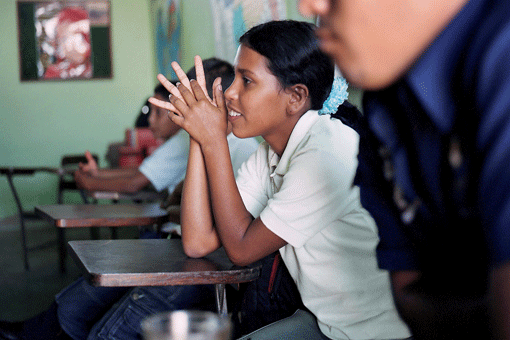Why is there such a pronounced racial gap in access to education and retention rates in Brazil? Finding the answer to that question is essential not only to improving Brazil’s overall educational (and economic) performance, but also to increasing social cohesion as the country seeks to become a major global economic player.
Research supports the consensus among educators and researchers that school indicators for Afro-Brazilian and Caucasian students are markedly and persistently different, favoring the latter. Data from 1995 to 2005 compiled by the Sistema de Avaliação da Educação Básica (National Basic Education Evaluation System, or SAEB by its Portuguese acronym), an assessment of student achievement developed by the Instituto Nacional de Estudos e Pesquisas Educacionais Anísio Teixeira at Brazil’s Ministry of Education and Culture (INEP/MEC), show that, when disaggregated by race and gender, the average performance of Afro-Brazilian students is consistently lower than that of their peers.
To examine the differences between Afro-Brazilian and Caucasian students,1 we used SAEB surveys involving two exams in math and Portuguese, administered biannually to a representative sample of students in 4th and 8th grades of elementary school and the third year of high school. Scores range from 0 to 500 points. All of the results are for public and private school students in urban areas only, except for those from the 4th grade, which also include rural schools.
The SAEB divides students into various racial categories based on self-identification. For the purposes of this article we have collapsed the appropriate race categories into “Afro-Brazilian” and “Caucasian.” (In the original language of the survey, the categories in Portuguese are negros, pardos/mulatos and brancos. For editorial reasons we define them as Afro-Brazilian and Caucasian.) In 2005, the most recent year of the SAEB survey from which we draw the bulk of our results, the share of Afro-Brazilians in all schools was 54.2 percent in the 4th grade, 52.4 percent in 8th grade and 49.7 percent in the third year of high school. Disaggregating by school type, in public schools Afro-Brazilians accounted for 55.9 percent, 55.3 percent and 52.7 percent of students from those three respective grade levels. In the case of private schools, Afro-Brazilians represented 40.6 percent, 32.3 percent and 32.1 percent, respectively. As we describe later, the difference in distribution between public and private school by race is important when discussing school quality.
Separate and Not Equal
When we disaggregate the 2005 SAEB test results for math and Portuguese by race, we find that Caucasian students perform markedly better in terms of knowledge and skills. Those differences also hold true across gender, with both Caucasian boys and girls performing better than Afro-Brazilian boys and girls in both subjects.
On the math exam in the 4th grade, the average performance of Caucasian students was 9.4 percent higher than that of their Afro-Brazilian peers; it was 8.3 percent higher in 8th grade and 7.8 percent higher for those in the third year of high school. The disparity persisted across gender. Caucasian girls scored 9.6 percent, 9.1 percent and 9 percent higher than Afro-Brazilian girls in those same three grades.
The same was true of the Portuguese exam, on which boys generally scored lower than girls. The scores for Caucasian boys in 4th and 8th grades and in the third year of high school were 7.5 percent, 7 percent and 6.6 percent higher than those of Afro-Brazilian male students. Among females, the performance was 8.8 percent, 7.3 percent and 9.1 percent higher (see table 1).
Traditionally, in testing, boys score better on math and sciences and girls score better on language, irrespective of race. What was striking in our results was that even in the subjects in which boys or girls were weaker, Caucasian students still outscored Afro-Brazilian students of the opposite gender. In 2005, the Portuguese grades for Afro-Brazilian female students were lower in all three grades compared to their Caucasian male peers. And the math scores of Afro-Brazilian male students were always lower than the scores of Caucasian female students.
Comparing 2005 with 1995, the grades of all students in all age groups underwent a downward trend in both tests, with one exception—a 7.9 percent increase in the math scores of Afro-Brazilian third-year high school female students. It was the only demographic sub-category among all the race and gender groups in both academic subjects that improved in that 10-year span.
It’s difficult to speculate what accounts for the decline in scores across subjects and racial groups from 1995 to 2005. One hypothesis is that the scores reflect the expansion of general enrollment since 1995. What is clear is that the quality of education has not kept pace with increases in student enrollment…
FOOTNOTES
1. Results for Asian students and indigenous students were not included in this study due to sample size.




